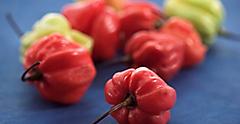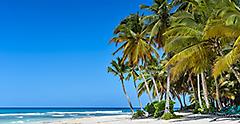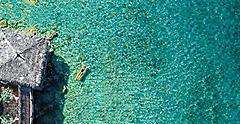6 Caribbean Islands With Delicious French Cuisine
By Mary Luz Mejia | Published on March 17, 2022
If you enjoy French Caribbean cuisine — that sultry mix of cultures, flavors and histories served alongside powdery sand beaches fringed by turquoise waters — these islands were made just for you.
The French Caribbean boasts Creole and French culinary influences that go back generations. Mix in culinary imprints left behind by Europe — France in particular, India, the Middle East and Africa — and you scratch the surface of the rich food history in this part of the Caribbean. We'll take a look at the islands' varied pasts, offer some must-try dishes on each island and where to get some of the best.
1) Guadeloupe
There are five main islands in an archipelago that make up the island chain known as Guadeloupe, which has been designated a Biosphere Reserve by UNESCO. Grande-Terre and Basse-Terre, the two largest islands, are connected by a short bridge. From the air, their outline forms butterfly wings. This part of the Caribbean offers stark and beautiful contrasts, from the snow-white sands of Plage Vieux Port and Plage Feuilliere in Marie-Galante, to the black sand of Plage des Bananier in Basse-Terre (great for beginner surfers).
The culinary history here features classic French cuisine with influences from Africa and India, along with Creole dishes. Many of the islands' dishes have roots in the food that slaves created to feed their own families, given that delicacies such as meat were only accessible to the landowners. Using the produce grown in the sugar plantations around them, the slaves made dishes that have been adapted with the introduction of new ingredients.
Nowadays, you'll likely be offered a rum-based aperitif called Ti' Punch (ti being short for the French word petit or small) made with a combination of lemon or lime juice, cane sugar and high quality rum. Sugar cane-based, agricultural rum is a huge part of West Indian culture — and while you'll find other cocktails on the menu, Ti' Punch is what locals enjoy before a meal. There are nine distilleries in Guadeloupe, including the award-winning Longueteau on Basse-Terre. The sugar cane here comes from the distillery's land, at the foot of the Soufrière Massif, allowing them to create a high quality rum considered some of the best in the French West Indies.
Your meal will likely include some just-caught seafood since Guadeloupeans are avid consumers of seafood. From grilled rock lobster, grilled fish, conch fricassee and a spate of flavorful Créole dishes, there's likely a seafood-based dish just for you. If you're on Grande-Terre, head to the historic Le Relais du Moulin's Le Mango Restaurant to find beautifully crafted French Caribbean fare amidst tropical gardens with a former sugar mill standing sentinel over the property. Wednesdays are Creole night at Le Mango.

They offer delicious dishes like cod fritter apps, known as accras, fish rillettes and chicken Colombo, a Creole dish of curry, turmeric, saffron and cumin spiced chicken. After your meal, try coconut blanc mangér, a dessert with Middle Eastern roots made with coconut milk and condensed milk, one of the French Caribbean's most prized desserts.
If you prefer something more casual, head over to the town of Sainte-Anne where a number of food trucks serve one of Guadeloupe's most famous street foods: the bokit and its larger version called agoulou. These are tasty made-to-order sandwiches with deep-fried, crispy bread, filled with anything from cod fish, chicken, ham and cheese or veggies and drizzled with a sauce.
You'd be remiss if you didn't try the islands famous kassav: a hearty treat made of fried manioc (or yucca) flour, stuffed with anything from cod to tropical fruit jams for a sweet version. Cassaverie Capesterre Belle-Eau not only shows you how they make the manioc flour, you'll also see your kassav made right before your eyes, customized to your wishes.
And before you go, try one of the area's most beloved desserts, the tourment d'amour (or torment of love), a pastry-lined tartlet filled with traditional coconut jam (or tropical fruit), covered with a fluffy sponge cake. It's a Terre-de-Haut specialty and there's an annual competition in town every Aug. 15 to crown the best tourment d'amour maker. Similarly, The Cook's Festival on the island, or Fête des Cuisinières also happens every August in the town of St. Laurent. This is another excellent opportunity to taste local dishes using age-old recipes, made by those who cherish Creole cuisine.
2) Martinique
Located on the Lesser Antilles of the Windward Islands of the Caribbean, where the north and south Atlantic meet, is the rugged island of Martinique. This overseas region of France boasts steep hills, towns with charming narrow streets, pristine beaches — both golden and black sand — and gastronomical greatness. Though Martinique is undoubtedly heavily influenced by France, and Napoleon's first wife Josephine was a native daughter, its culture spans across French, Creole and African influences.
Its residents happily shop for foie gras and pate in Parisian-like supermarkets, while their meals are liberally sprinkled with piment (hot pepper) and sauce chien, or hot sauce or served with a twist of tropical fruit. While the national dish of Colombo or Colombo de Martinique is a spicy curry-based meat dish traditionally made with coconut milk, a prime example of how the French motherland influences cuisine here is reflected in the fact that this dish is often made with wine as a substitute for the coconut milk; it's a nod to the old country while still retaining the Caribbean flair.
As with the neighboring islands, expect to be greeted with Ti' Punch, though that might be switched up for a planteur (fruit juice and rum) or even a delicious shrub (rum with marinated orange rinds) at Christmas. Martinique has a proud history of fine rum, particularly their rhum agricole, a fragrant rum produced from sugar cane (as opposed to molasses) and requiring 220 lbs of sugar cane to produce a mere 2.5 gallons (9.46 l) of rum. There are a number of distilleries on Martinique, the oldest being Saint James. As a result of its strong links to France, the rum produced here is labeled as a product of France.
Martinican cuisine will naturally tip its hat towards the abundant seafood and tropical produce available. The spicy crab matoutou for example, is a slow-simmered crab stew that is served at beach time family gatherings during Easter. The French influence is never far away though, as is evident in the regular consumption of boudin (pig's blood sausage) at most holiday gatherings. This island clearly loves its food — there a few hundred restaurants and regular food festivals abound. The Kreol Food & Rhum festival is a week-long food festival usually held in October, showcasing Creole cuisine, French Caribbean chefs and local products.
If you're looking to experience Martinican flavors away from the crowds, then you're blessed with options both high-brow and casual. La Table de Mamy Nounou is renowned for its great view and even better menu. It serves a typical Franco-Caribbean mix of meat and fish, from suckling pork to snapper tartar. Likewise, Le Belem offers French-inflected dishes like local duck breast confit with shallots, but doesn't forget its Caribbean surroundings with a host of ceviche and traditional/new age pairings of chayote pie with black truffle.
If you're in the mood for something easygoing, head to the covered market in the capital Fort-de-France and seek out Chez Carole for some delicious accras (cod fish fritters), knock back a homemade rum punch and enjoy the sunshine. If you've satisfied your snack tooth, then look for Ziouka Glace near the Le Carbet beachfront and you've found the ultimate sweet finish — locally made ice creams featuring island ingredients like vanilla bean, passion fruit and guava.

Book Now
3) Saint-Barthélemy
St. Barth, as this French island is colloquially called, is almost 10 square miles and a mere 12-minute flight from St. Martin. With next to no proper agriculture on the island, and a food culture that's very heavily influenced by France in particular and Europe in general, this is an island where Michelin-starred chefs have outposts and mostly European, affluent visitors (and villa owners) are used to the finer things in life.
Every year, the St. Barth Gourmet Festival gathers French Michelin-starred chefs, flown in with their dishes' corresponding ingredients, to prepare gala dinners. According to the festival's site, the week-long celebration brings the very best French chefs and their creations together with regional ingredients for what's described as "jubilant festival goers." If you're not on the island during festival time, you can enjoy St. Barth's culinary scene on your own. There's no shortage of choice for fine dining options and toes-in-the-sand, beach-side eateries that offer a more low-key vibe.
One of those is Eddy's Ghetto, which is actually in a downtown Gustavia garden setting serving the island's most enjoyed Creole food. Grab some accra cod fish fritters, fresh seafood curries such as wild prawns or stuffed, spiced crabs for dinner. If it's a seaside, casual lunch you're after, you're in excellent hands at the local favorite, La Gloriette. Under the shade of coccoloba trees, there's a little yellow-trimmed place on Grand Cul de Sac serving up freshly grilled mahi-mahi, blood sausage and shrimp green curry. While away an afternoon with good food, wine and a view of local fishermen pulling up in their boats. Don't miss the chef/owner Albert Balayn's famous amber or golden rums infused with banana, coffee or pineapple, according to the season. Note: This little gem is closed on Wednesdays.

4) Saint Martin
Saint Martin is part of the Leeward Islands in the Caribbean Sea, and is actually two separate countries, the northern French Saint-Martin and the southern Dutch Sint Maarten. Christopher Columbus first set his sights on the island during his second voyage in 1493. He named it Isla de San Martín after Saint Martin of Tours as it was the saint's feast day, but he never actually set foot on the island and it was deemed a low priority by the Spanish government of the time. The island was eventually deserted by the Spanish, only to be grabbed by nearby European colonial powers France and Holland. While the two did not initially see eye to eye on splitting the island, they eventually signed a treaty to share the territory.
As with most Caribbean islands, there was a history steeped in plantations and slaves, though with the abolition of slavery came a lean economic period for the island, one that was initially boosted by its declaration as a duty-free port, and then from the 1950s onward, as a tourist destination. The resultant mix of cultures has produced a typically Caribbean blend of French, Creole and African influences and flavors.
Rum, the spirit in the Caribbean, is especially popular in Saint Martin, though there is a unique twist here: the guavaberry. Using fine oak-aged rum and cane sugar, wild Saint Martin (Sint Maarten more likely) guavaberries are added to create a slightly woody, bittersweet resulting liqueur that is a symbol of the island and certainly a delicious memory to take home with you.
As far as dining goes, Saint Martin is quite possibly the easiest place to find a delicious meal. Just head to the village of Grand Case. Called the gastronomic capital of the Caribbean, the restaurant row on Boulevard de Grand Case offers diners all manner of options, from high-brow French eateries to mixing it with the locals at the numerous casual eateries or "lolos."
Le Pressoir features the best of both worlds in a number of ways, offering the best of French and local ingredients as well as a good mix of meat and seafood options. They also offer seasonal menus using 80% local ingredients, plated beautifully in an elegant setting. Another fine dining option is Ocean 82, which is also one of the few upscale eateries that offers service all day. Keeping it casual doesn't mean forsaking quality or flavor. The lolos offer a variety of treats, from barbecued ribs to grilled lobster and local snapper. If you want to end on a sweet (and local) note, then spring for a johnnycake — delicious fried dough that is found across the island. If you happen to be traveling mid-January to early March, then stay after dinner and enjoy their Les Mardis de Grand Case every Tuesday night, during which the streets are closed to traffic and a bona fide street party breaks out!

5) Dominica
Apart from being where "Pirates of the Caribbean: Dead Man's Chest" was shot, Dominica is a green, lush island ideally suited for those who like jungle and volcano hiking/trekking, soaking in natural hot springs, swimming in waterfalls and eating robust, Creole-influenced foods. Many top Dominican dishes stem from the African slaves and Carib indigenous peoples, but with the introduction of French, Asian and Indian peoples, the addition of various culinary techniques, rice, curries and spices soon followed. If you're looking for a less touristy island with extremely hospitable people in which to savor French Caribbean fare, Dominica might just be for you.
Another bonus for good food lovers is that Dominica produces an abundance of sustainable, often organic fruit and vegetable crops bringing you some of the freshest, most flavor-bursting tropical produce you've likely ever tried. This explains why most Dominicans like to accompany a meal with a glass of fresh, tropical fruit juice. The island's abundant reefs mean that just-caught fish, conch and crabs are always on the menu served with sweet, ripe plantains, breadfruit, yams or cush cush, a cornmeal side dish.
Much like the island, Keepin' It Real does just that by sourcing its fresh seafood from local fishermen and produce from local farms and farmers' markets. The owner has had to reopen the place twice, once due to hurricane Maria in 2017 and the second due to a fire in 2019. Nowadays, you'll find this local hot spot in its third and hopefully final location in Toucari, St. John, a lovely bay that offers a sunset-perfect dinner spot (or pretty lunch location). Known for the grilled lobster with rice and "provisions" (a variety of cooked root veggies), you'll want to get that with a side of island Kubuli beer.
If you're driving around the mountains looking for a clear view of the Castle Bruce Islets in the bay, you'll want to make a pit stop at aptly named Islet View Restaurant & Bar. It's a roadside shack offering frosty ginger beer in coconuts and about 50 varieties of their own, island-made bush-rum cocktails that are sure to please. Start with the fried plantain and spicy dip, move on to a spicy curry chicken or stewed chicken main dish and finish off with sugar cane and fresh tropical fruit plate for dessert.
Down by the water, you're in good hands at Escape Beach Bar & Grill surrounded by the natural Red Rocks of Pointe Baptiste in Calibishie. Enjoy a catch of the day under a swaying palm, along with local produce prepared simply and deliciously, according to what's available daily. Check the beachside blackboard for the day's menu which might include grilled tuna, a freshly grilled lobster salad or fish cakes accompanied by a bottle of French wine.
If you're the adventurous sort, look out for manicou; a fire-smoked opossum stew seasoned with spices and scotch bonnet peppers, served with rice and root veg. Or stick with a Creole favorite: callaloo soup made with the leaves of the callaloo plant, vegetables and broth for a herb and spice inflected taste of the Caribbean in a bowl.

6) Saint Lucia
Though it was sighted by various explorers throughout the 1500s, the St. Lucia we know today wasn't inhabited by any Europeans until the 1600s, when the crew of a British ship that was blown off course on the way to Guyana ended up stranded there. They eventually left under threat of constant attacks by some of the indigenous tribes, though this only served to start a series of invasions and counter invasions between France and England that lasted almost 300 years, until St. Lucia began forming its own representative government in the early 1920s. It remained strongly connected to the U.K., however, and only gained full independence in 1979.
Unlike some of its nearby neighbors, St. Lucian culture has a strong English influence (along with that of France, India and West Africa). English remains its official language, though Kreole (French patois) is heard across the island. Similarly, the cuisine of St. Lucia leans more towards that found in other commonwealth Caribbean nations such as Dominica, Jamaica, St. Vincent and Trinidad. Scotch bonnet peppers abound, rice and peas (beans) can be found everywhere and curries are popular thanks to the influence of the Indo-Caribbean population.
The go-to dish for any visit to St. Lucia is green figs and saltfish, which doesn't actually contain figs but rather boiled green plantains which are herbed, spiced and served alongside salt cod. Get a fine farm-to-table version of this national dish at Dasheene at Ladera, situated on a dramatic volcano ridge line 1,000 feet (0.3 km) above the Caribbean (a UNESCO World Heritage Site), overlooking the Pitons. Executive chef Nigel Mitchel and his staff serve modern interpretations of St. Lucian dishes crafted with native ingredients from island farmers. You can also enjoy the roast conch with pickled veg served in a yam basket, Creole vegetable bakes, jerk poulet sausage or plantain gratin with coconut rum sauce for a sweet ending.
Another must-try, award-winning hot spot is Orlando's Restaurant & Bar helmed by Caribbean cuisine ambassador, Orlando Satchell in one of two island locations: Soufrière, and the more recently opened Rodney's Bay. His menu is described as "a locally focused journey through Saint Lucian cuisine" including the island's famous green figs and saltfish served with pepper aioli, or a Piton Poulet, chicken seasoned with herbs, ginger and marinated in local Piton beer, served with a coconut sauce.
For a true, relaxed St. Lucian "jump up" head to Anse la Raye, north of Soufrière and hang with the locals. This fishing village is known for their Friday night fish fry featuring freshly caught seafood, bakes (fried bread), island beer and a side of DJ-spun tunes to dance the night away.
Any way you slice it, there's a treasure trove of Caribbean dishes, islands and cultural combinations to discover. Start with a four-day cruise, to whet your appetite and bon appetit!








